|
|
|
|||
|
|
||||
|
|
||||
| The (Jet)X Files | ||||
|
|
HOME | SITE MAP | FORUM | CONTACT |
|
||
|
ABOUT | MOTORS | MODELS | ARCHIVE | HISTORY | STORE | FAQ | LINKS
|
|
|
|
|
|
|||||||||||||||||||||||||||||||||||||||||||||||||||||||||||||||||||||
|
The (Jet)X Files 23
(November 2004)
by Roger Simmonds Reprinted from SAM 35 Speaks, November 2004 (with corrections) State of Efflux First, please note the change of address. Moving to temporary accommodation has inevitably caused disruption to this year’s building programme and affected my ability to answer correspondence in a timely manner. I have a computer ‘hard disc’ problem as well, so please forgive me if your letter or e-mail has gone unanswered; I hope to get back on track soon. Having exchanged proximity to Old Warden for proximity to Middle Wallop, I looked forward to attending this event for the first time. Unfortunately the weather that particular weekend was most uncooperative and I have little to report, apart from meeting Phil Smith – of whom more later. I also missed Peterborough ‘Flying Aces’. Mike Stuart reports it was blessed with wonderful weather (again!), but few people were flying jets, and only he and Chris Strachan entered the Rapier event. On a happier note, Pete Williams will have his new website, Petesplans, up and running soon, and Terry Kidd’s Jetex site, which was the first of its kind and an inspiration to us all, is back online at jetexsystems.pwp.blueyonder.co.uk/jetex_home.html. |
|
|||||||||||||||||||||||||||||||||||||||||||||||||||||||||||||||||||||
|
Following September’s discussion of the innovative Veron ‘Scale-jet’ kits, Phil Smith (whose new drawing of the Thunderjet is shown right) sent me a copy of his retraced plans for the Seahawk. It now shows a Rapier L2 and displays the Aerographics logo; very nice, but it’s a pity some of the explanatory diagrams that adorned the 1951 original were discarded. Phil writes: “Nice to see the old illustration of the Thunderjet, which was one of my own original photos of the series”. “The undercarriages were added to make them look more authentic (photographer’s licence), but for expediency and to save weight, they were omitted from the kits and on the plans. Nor, I’m afraid, did the kit list include rubber for catapult launching!”. Phil is not sure how George will reproduce the printed wood parts for the resurrected kit. Though the new plan lacks some nostalgic details (right), there is, in compensation, a large 3-view detailing the colour schemes and squadron markings that can add, like ersatz undercarriages, so much to the verisimilitude of this type of ‘stand well off’ scale model. Rapier Matters Availability has been somewhat sporadic this year, though, contrary to recent rumours, Rapiers can still be sent through the post. I have had sufficient stocks as my flying has been curtailed through personal circumstances and the somewhat inclement weather that has attended our meetings. At this rate I have enough L2s to last some years – that is, if they keep. Whilst original Jetex pellets, whether ICI or Sebel formulations, are not hygroscopic and appear to keep forever, there is some indication that Rapiers have a ‘best before’ date and it is unwise to hoard them more than a couple of years. I wonder if they keep better in the freezer? Some time ago, before Rapiers were available in quite the variety of ratings they are now, it was suggested that they could be left in a damp place to absorb moisture; this would retard the burn rate and enable less stressful trimming at a reduced thrust. The experts opined that any effect would at best be unpredictable and at worst make the propellant useless except as fertiliser. I do not know if anybody actually tried it, but the poor weather this year led to an inadvertent experiment. Early in the Spring I was delighted to order several boxes of the (then) elusive L2 HP. I was less delighted when the postman left the precious parcel outside the back door, open to the elements. The packaging, I found to my horror, not particularly waterproof. “Oh well”, I thought, “Rapiers are moisture resistant”, and hid them in the airing cupboard. I then forgot all about it, and tried this batch at August’s SAM Gala in a state of blissful ignorance. The motors proved difficult to ignite and gave no better than a powered glide from the normally oh so reliable MiG 15. This was most frustrating. I tried one in my FD 2; this was a little better – a longer glide. Whatever was the matter? Then I remembered the motors’ earlier baptism. Their thrust was (I would guess) about 80 mN, though the burn time was longer. Rapiers, then, can degrade and are not impervious to moisture, so: (a) store them in a warm dry place, and (b) could suppliers please, please, secure boxes in a waterproof package before dispatch? As has been discussed before, Rapier exhaust is hotter and smokier than Jetex. This can be a problem with (authentic) conversions of small gliders like the Keil Kraft Cub or Veron Coronette to reaction power. Both Andy Blackwell and Mike Stuart have Cubs that go very well with L2 LTs (but do fit a D/T!). Remember, though, that whilst the exhaust from a Jetex 50 endangered neither the tail feathers nor the fuselage, a Rapier will require additional protection of exposed surfaces. |
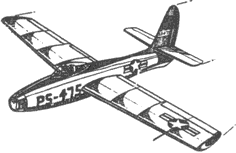
- Phil Smith's catalogue of plans, 2004
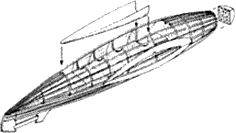 Phil Smith's Seahawk 1051 for Jetex 50 (1950) - construction diagram
- Phil Smith
|
|||||||||||||||||||||||||||||||||||||||||||||||||||||||||||||||||||||
|
Albert Hatfull’s Dolphin had a good glide, but the wing spars were inadequate for towing and limited its performance. I don’t know if a Jetex 50 was indicated on the original plan, but Howard Metcalfe’s clever Rapier conversion (rubber bands secure both the wing and the motor mount, see right) flies beautifully, revealing the potential of this graceful design. The motor arrangement provides useful downthrust and the L2 HP’s exhaust is (it might be thought) well out of harm’s way. Unfortunately, burn holes soon appeared in the Mylar covering – caused by spluttering fuses, not motor exhaust! Leigh Richardson uses quite a substantial foil strip to preserve the underside of his L1/L2 powered Zephyr. Troughs of depression The ubiquitous trough is a continuing, indeed chronic, source of angst to us Rapier fliers. Like many others, I line these ‘neat grooves’ (as an early Model Aircraft review called them) with Halford’s foil tape. This is light and, being sticky-backed, very convenient. However, it does corrode quickly; the surface then becomes less heat reflective and scorching or even fires can result. Wiping away the sooty deposit with Boots’ ‘Basic Wipes’, (much more effective than tissue and spit!) can ameliorate corrosion, but even so I find myself replacing the foil after 8-12 flights. This is not easy as it remains very sticky. Howard recommends heavier ‘Chinese takeaway’ foil. This lasts longer and can even cope with several degrees of downthrust, where motor exhaust is inevitably deflected off the trough surface. However, replacement is still necessary from time to time. Has any reader a better solution to the ‘trough lining’ problem? Does anybody know of a suitable heat resistant paint? |
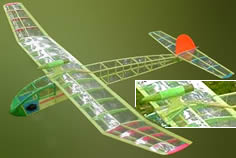 Hatfull’s Dolphin - Rapier conversion by Howard Metcalfe (inset shows detail of motor and wing attachment)
- Howard Metcalfe
|
|||||||||||||||||||||||||||||||||||||||||||||||||||||||||||||||||||||
|
|
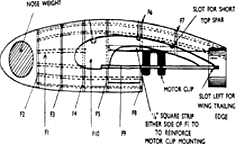 Wilmot Mansour Vampire - motor mount  'Tailored' Voodoo, built by Andy Blackwell
- Andy Blackwell
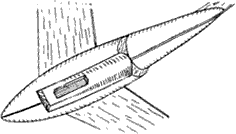 'Tailored' Voodoo motor mount  Boys' Vampire motor mount
- Howard Boys
|
|
||
|
The early Wilmot Mansour scale models were troughless; the Vampire’s Jetex 50, for example, was put in a ‘bomb bay’ firing through a paper ‘jet pipe’ (right) – an expedient quite impractical with a Rapier. Most tailored models had enclosed motors, but there was no attempt to hide the Atom 35 in the later Sea Vixen, X-15 and Temco TT-1 and the elegant lines of the moulded fuselages were quite spoiled. The 1952 Voodoo (Bert Judge’s first ‘Tailored’ design) had a hollow monocoque fuselage, but the Jetex 50 was mounted in a shallow trough lined with asbestos that didn’t extend much beyond the wing trailing edge (see below right). Andy Blackwell’s vintage Voodoo is on the right. Note the exposed motor clip. A Rapier is feasible in this position, but the rear fuselage, though it is well away from the exhaust, might still get scorched. Andy has a large collection of Jetex motors and stocks of propellant should he wish to give his Voodoo an airing – it was by all accounts a wonderful flier – but it is probably too precious to risk in flight. Perhaps one could do away with the trough altogether. Howard Boys’ 1947 ‘Powakits’ free flight Swallow and Vampire predated Jetex and were propelled by small rocket motors made by Brocks to his own specification (see (Jet)X Files, August 2003). As these used black powder, the exhaust would have been quite incompatible with thin aluminium (and here I speak from experience!). The Vampire is, you will remember, a most attractive model with the extended elliptical wing tips and characteristic angular fins of the early marques. The motor is mounted at an extreme angle in the rear of the fuselage (see right). Boys’ design is better looking and more ‘true to scale’ than the later Wilmot Mansour kit, and more practicable than Cockle’s large and I have long been contemplating a Boys’ Vampire (to match Chris Strachan’s lovely L1 Swallow), though with a trough and an L2 in the traditional position. This modification, as well as being a trifle pusillanimous, may actually be unnecessary. Chris thinks the Rapier could be retained in the original location: the model is trimmed with a rearward CG and the massive downthrust prevents an initial ‘zoom to doom’; as the motor burns, the CG moves forward, ready for (one lives in hope) the gliding phase. Hmm … it’s worth a try; after all, if it worked in the old days, why not now? Or have I missed something? Not only would the jet exhaust from the proper orifice, the model would also be ‘authentic’ and might even be allowed in an Eddie Riding contest. |
|
|
|
|||
|
The Orange Peril and the Origins of Jetex Stories about this singular six-foot aeroplane appear in SAM Speaks from time to time; for example, April’s ‘Gliderscope’ included a sad story of John Ralph (who I’m sure knows better now) chucking one to its doom off the edge of a quarry. A fine example of the IMA WWII artefact was exhibited at Tangmere [above right]. Curiously, it had a most ill informed and misleading label [below right], suggesting it was “based on the design of the Slingsbury Sail plane”, “powered by a ‘JETEX’ unit”, and dropped from a mother craft, collecting data “for the ground boffins”! Many thousands of these target drones (for that is what they are) were built, and they still turn up from time to time; John Harvey has one and David Bintcliffe bought another at an auction recently [see photo below right]. However, it would appear from my correspondence that David Carpenter’s ‘potted history’, published on the Jetex Engineering Works website some years ago, is not as well known as I had thought, so a ‘definitive’ history especially for SAM Speaks may be in order. First, here are Dr Bintcliffe’s first impressions: “It came complete in a very heavy duty cardboard box [this is unusual] and it is in good condition apart from some wrinkles in the wing covering and a few [bullet?] holes filled over with paper. The fuselage has a beefy hardwood crutch covered by papier mâché side-shells with wings set at what seems to be a very high angle of incidence. All aerodynamic surfaces plug in with very small tongues.” “The plane weighs what seems like a ton with a very high wing loading. The rocket motor fits in a circular slot under the wings [see right]. There is what appears to be a metal mounting/catapult bracket underneath and a Fierce Sticker saying, ‘Government Property, return to the nearest Police Station if found’. If it flew [at all] it would appear dangerous and an accident waiting to happen.” I concur with David’s observations, and the machine really is quite startling when first encountered. However, Bert Judge confirms that they did fly and many were shot down, which seems rather a pity. According to David Carpenter, they weighed about six pounds, and the Bakelite cased motor (which itself weighed two pounds) had a cordite-based propellant. Its thrust was “just under three pounds”. Bert, who was associated with IMA from before the war, narrates the story of the IMA target drone thus: “At the start of the war, I was working on a six-foot streamlined glider kit design with cranked wing dihedral and a fully planked fuselage. It towed up beautifully and we had no trouble flying it. Joe Mansour was approached by Commander Norway (Neville Shute) who was attached to weapons development at the Admiralty. He asked us to design a free flying glider (no cranked wings as in my earlier model, but straight dihedral) to enable merchant seamen to get experience in ‘laying off’, that is, aiming in front of the aircraft so that the bullets reached it at the proper time. Gunners were firing at aircraft and of course missing them completely. Mr Slater [a manager at the Air Ministry] was expert in spindling wood and he had methods of producing a streamlined fuselage requiring very little handwork to finish. We did have trouble (because of the extra weight) of weaving on the towline. It was Mr Vanderbeek [another IMA employee] who suggested the solution. I was thinking about an underfin but he suggested, ‘Why don’t we try twin fins?’, which we did and worked perfectly. It went into production for the D.M.W.D and was flown by Wrens to train in eye shooting. Following that free flying glider, we were asked to do a thirty-foot smoke-laying aircraft powered by four cordite rockets. This was the beginning of Joe Mansour’s interest in slow burning rocket fuels. So really, that is how Jetex started, ‘the early origins’. Gunnery practice with the [gliding] six-foot models was successful, in fact too successful. They wanted higher speed, a much faster flying model. Now this was designed by Sydney Hansell (who was the designer of the smoke-laying aircraft) and was of pod and boom construction.” “These were the orange aircraft available in army surplus stores after the war. Joe Mansour designed a catapult, which was essentially a wooden structure with three half-inch diameter bungee rubbers that shot the model off at its flying speed. The aircraft were powered by a single rolled cordite rocket motor produced by Woolwich arsenal, which gave you a steady thrust for the required period. These inspired Joe Mansour to get in touch with I.C.I to produce a model rocket fuel after the war.” I am very grateful to Bert for his “true story of the IMA Target drone”, and to Andy Blackwell for preparing the transcript. The tale is a wonderful example of British Wartime ingenuity and Joe Mansour’s (and his colleagues’) genius. I have two questions. What exactly did the MOD expect people to do with all those army surplus models? The pod and boom layout is eminently suited to Rapiers – who will be the first to fly a quarter-scale replica? CO2 Jets Revisited It transpires that the ‘Jets Ray Jet-Racer’ illustrated in September’s column had a stable-mate: the ‘Jet-Wing’. Ben Nead writes; “Ray [not ‘Jets Ray’ as I had thought] were a division of the ‘Aircraft Products Company’; their line of cold reaction CO2 model kits was, perhaps, the earliest marketing attempt of its kind. The Ray Jets appeared in US modelling magazines like Air Trails and Model Airplane News as early as January 1945. By the middle of that year they were extolling the virtues of CO2 reaction power quite aggressively with full-page spreads, and then to a lesser extent until shortly before the introduction of Jetex to the US in late 1948. You still saw Ray adverts for solids and rubber power scale until the early 1950s but any mention of the Jets was long gone by then.” |
 IMA target drone, Tangmere Aviation Museum 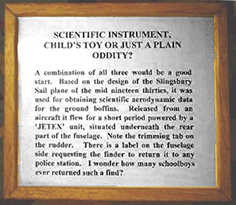  IMA target drone – rear view
- photos by Howard Metcalfe
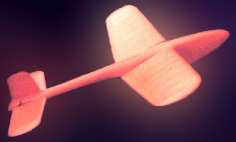 David Bintcliffe's IMA target drone
- David Bintcliffe
|
|||

The CO2 bulb was attached by rubber bands and pierced by a gun-like contraption. Ben, proud owner of these kits, comments, “The language in a January 1945 advert is quite out-RAY-geous “ [sigh] and provided the extract below.”
|
|
 Ray Jet-Wing
- Pete Williams
|
||

This is all novel and fascinating stuff. Pete Williams has plans for the Ray Jet-Wing, and also, wonder of wonders, for the Shooting Star [above right]. Note the method of launching [right]; two people are recommended, but the ‘launching gun’ is merely hinted at. Pete says the 18½" span 17" long design is especially interesting, despite some scale anomalies, as the P-80 was all but ignored on this side of the Atlantic. The fuselage is fully sheeted, but the design is otherwise conventional and should convert nicely to Rapier L2 power if built around 13"-15" span. It would be, like the Powakits Vampire, unique and authentically vintage. |
|
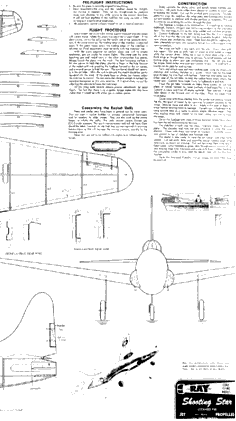 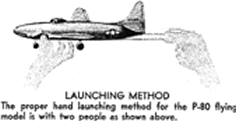 Ray Lockheed P-80 Shooting Star
- Pete Williams
|
||
|
|
||||
|
|
|
|||
|
|
|
|
|
|
|
|
Acknowledgements - Article: Roger Simmonds - Information: David Bintcliffe, Bert Judge, Ben Nead, Phil Smith - Illustrations: Roger Simmonds, David Bintcliffe, Andy Blackwell, Phil Smith, Howard Metcalfe, Pete Williams, MAAC archives via Bill Henderson |
|
|
|
|
ABOUT | MOTORS | MODELS | ARCHIVE | HISTORY | STORE | FAQ | LINKS |
|
|
Terms of Use
|
Queries? Corrections? Additions?
Please
contact us.
|
|